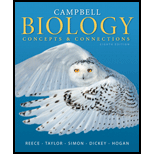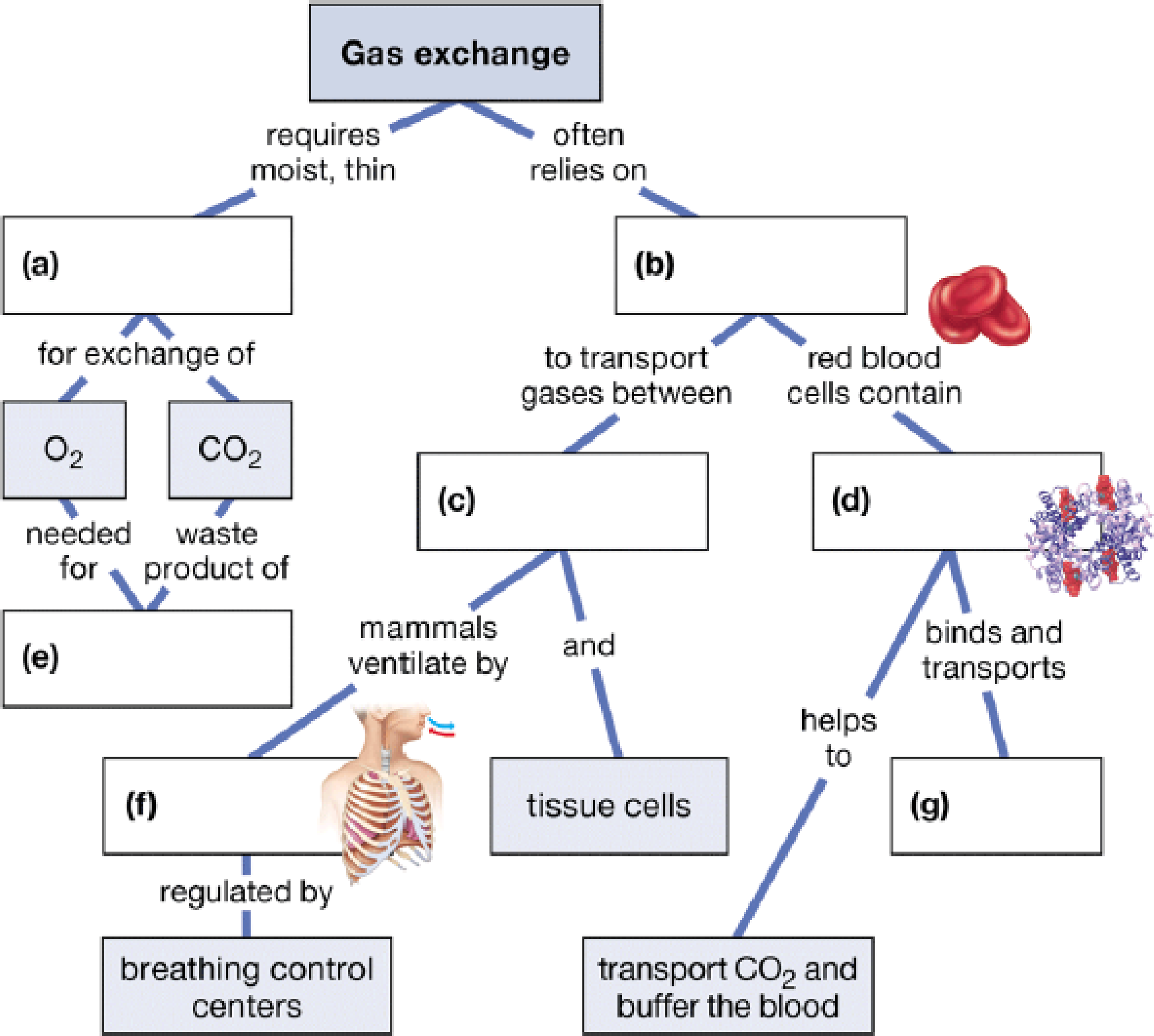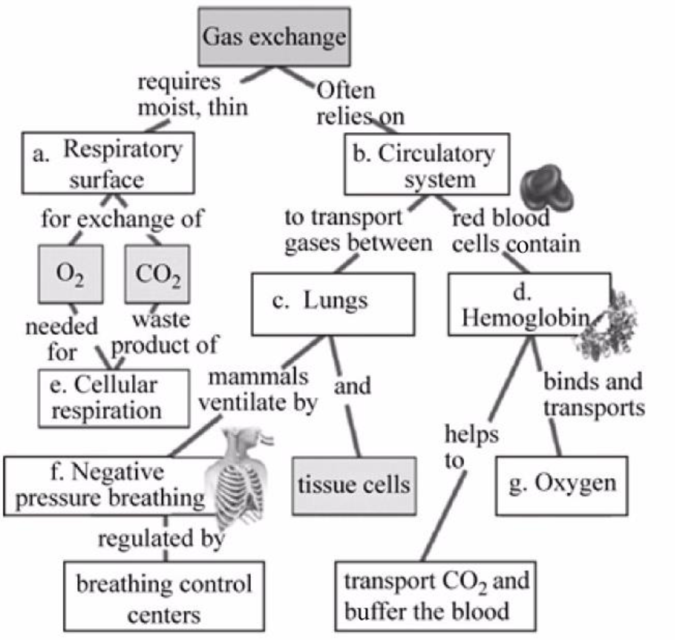
Concept explainers
Complete the following concept map to review some of the concepts of gas exchange.

To complete: The given map to review some of the concepts of gas exchange.
Introduction:
The respiratory system is a biological system that ensures the transport of air by the process of inhalation and exhalation, that is, in and out the body with the help of the lungs.
Answer to Problem 1CC
Fig.1 shows the completed map to review some of the concepts of gas exchange.
Pictorial representation: Some of the concepts related to gas exchange are presented in the concept map given in Fig.1.

Fig.1: Concepts of gas exchange.
Explanation of Solution
a.
Correct answer: Respiratory surface.
For gas exchange to occur, the respiratory surface should be thin and moist. Hence, the correct answer is the respiratory surface.
b.
Correct answer: Circulatory system.
Gas exchange relies on the circulatory system as the exchanged oxygen and carbon dioxide travel in the blood to the heart and different body cells. Hence, the correct answer is the circulatory system.
c.
Correct answer: Lungs
It is the main organ for the exchange of gases consisting of air sacs that carry out gaseous exchange and the blood carries the exchanged gas to the tissue cells. Hence, the correct answer is the lungs.
d.
Correct answer: Hemoglobin.
Hemoglobin is a blood pigment present inside the red blood cell, which helps in the transport of oxygen and carbon dioxide by binding with it and also maintains the pH of the blood. Hence, the correct answer is hemoglobin.
e.
Correct answer: Cellular respiration.
In cellular respiration, oxygen is used to convert glucose into carbon dioxide, water, and energy in the form of ATP. Hence, the correct answer is cellular respiration.
f.
Correct answer: Negative pressure breathing.
This type of breathing is regulated by the “breathing control center of the brain”. In negative pressure breathing, the air pressure inside the lungs drops during the contraction of the diaphragm, and the lower portion of the chest cavity rises; this allows the movement of air from outside to inside. Hence, the correct answer is negative pressure breathing.
g.
Correct answer: Oxygen.
Hemoglobin pigment in the blood binds with the oxygen present in the lungs, and this oxygen is utilized to form energy. Hence, the correct answer is oxygen.
Want to see more full solutions like this?
Chapter 22 Solutions
Campbell Biology: Concepts & Connections (8th Edition)
- Can I please get this answered with the colors and how the R group is suppose to be set up. Thanksarrow_forwardfa How many different gametes, f₂ phenotypes and f₂ genotypes can potentially be produced from individuals of the following genotypes? 1) AaBb i) AaBB 11) AABSC- AA Bb Cc Dd EE Cal bsm nortubaarrow_forwardC MasteringHealth MasteringNu × session.healthandnutrition-mastering.pearson.com/myct/itemView?assignment ProblemID=17396416&attemptNo=1&offset=prevarrow_forward10. Your instructor will give you 2 amino acids during the activity session (video 2-7. A. First color all the polar and non-polar covalent bonds in the R groups of your 2 amino acids using the same colors as in #7. Do not color the bonds in the backbone of each amino acid. B. Next, color where all the hydrogen bonds, hydrophobic interactions and ionic bonds could occur in the R group of each amino acid. Use the same colors as in #7. Do not color the bonds in the backbone of each amino acid. C. Position the two amino acids on the page below in an orientation where the two R groups could bond together. Once you are satisfied, staple or tape the amino acids in place and label the bond that you formed between the two R groups. - Polar covalent Bond - Red - Non polar Covalent boND- yellow - Ionic BonD - PINK Hydrogen Bonn - Purple Hydrophobic interaction-green O=C-N H I. H HO H =O CH2 C-C-N HICK H HO H CH2 OH H₂N C = Oarrow_forwardFind the dental formula and enter it in the following format: I3/3 C1/1 P4/4 M2/3 = 42 (this is not the correct number, just the correct format) Please be aware: the upper jaw is intact (all teeth are present). The bottom jaw/mandible is not intact. The front teeth should include 6 total rectangular teeth (3 on each side) and 2 total large triangular teeth (1 on each side).arrow_forward12. Calculate the area of a circle which has a radius of 1200 μm. Give your answer in mm² in scientific notation with the correct number of significant figures.arrow_forwardDescribe the image quality of the B.megaterium at 1000X before adding oil? What does adding oil do to the quality of the image?arrow_forwardWhich of the follwowing cells from this lab do you expect to have a nucleus and why or why not? Ceratium, Bacillus megaterium and Cheek epithelial cells?arrow_forward14. If you determine there to be debris on your ocular lens, explain what is the best way to clean it off without damaging the lens?arrow_forward11. Write a simple formula for converting mm to μm when the number of mm's is known. Use the variable X to represent the number of mm's in your formula.arrow_forward13. When a smear containing cells is dried, the cells shrink due to the loss of water. What technique could you use to visualize and measure living cells without heat-fixing them? Hint: you did this technique in part I.arrow_forward10. Write a simple formula for converting μm to mm when the number of μm's are known. Use the variable X to represent the number of um's in your formula.arrow_forwardarrow_back_iosSEE MORE QUESTIONSarrow_forward_ios
- Basic Clinical Lab Competencies for Respiratory C...NursingISBN:9781285244662Author:WhitePublisher:Cengage
 Anatomy & PhysiologyBiologyISBN:9781938168130Author:Kelly A. Young, James A. Wise, Peter DeSaix, Dean H. Kruse, Brandon Poe, Eddie Johnson, Jody E. Johnson, Oksana Korol, J. Gordon Betts, Mark WomblePublisher:OpenStax College
Anatomy & PhysiologyBiologyISBN:9781938168130Author:Kelly A. Young, James A. Wise, Peter DeSaix, Dean H. Kruse, Brandon Poe, Eddie Johnson, Jody E. Johnson, Oksana Korol, J. Gordon Betts, Mark WomblePublisher:OpenStax College





